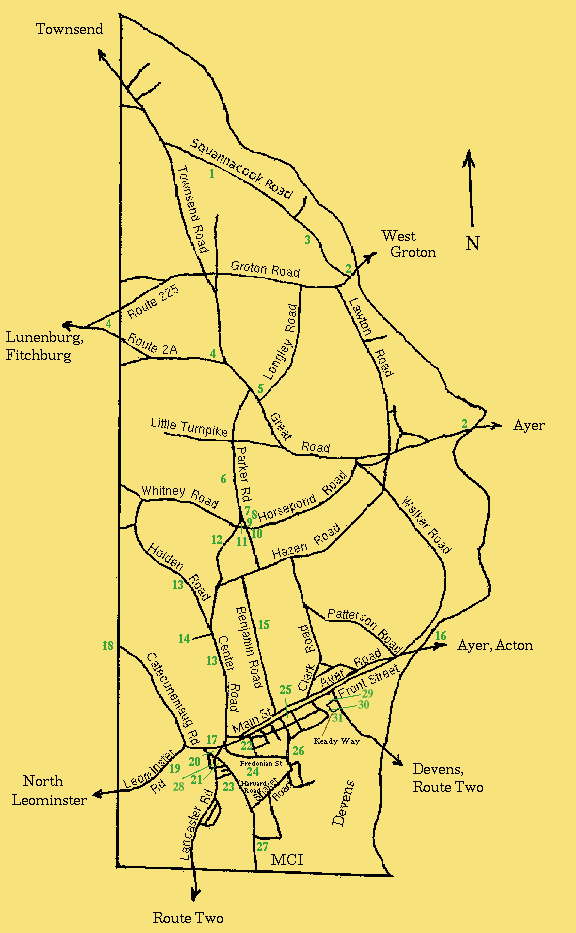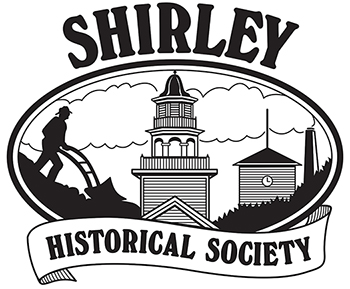
Squannacook Hiking Trails
Entrance to Upper Squannacook River Hiking Trails.Squannacook Boat Launches
Entrances to Squannacook River boating launch sites.Oliver Holden Birthplace
Birthplace of Oliver Holden, Composer of hymn “Coronation”, one of the hymns known by memory by Civil War soldiers. His book “Worcester Collection of Sacred Harmony” was the first book printed on movable type in the U.S.Mulpus Brook Boat Launches
Entrances to Mulpus Brook boating launch sites.Bull Run
Bull Run Tavern and Restaurant.Early 19th-century building.
Features a recent-vintage covered bridge behind the restaurant.
MacKaye Cottage
MacKaye Cottage.Built 1836. In 1886 actor Will MacKaye bought the cottage for his aunt Sadie Pevear who brought her relatives to live with her.
The MacKayes:
Benton (1879 – 1975) – founder of the Appalachian Trail
Percy (1875 – 1956) – dramatist
Hazel (1880 – 1944) – suffragette
Steele (1842 – 1894) – actor, producer, author, inventor
Town Hall
Built 1847 in Greek Revival style. It was struck by lightning in 1950 and rebuilt by Lucien Gionet.
Within the Shirley Center National Register Historic District.
Town Pound
Constructed in 1791. Used for stray animals.Within the Shirley Center National Register Historic District.
First Parish Meetinghouse
First Parish Meetinghouse built in 1773 in the center of the Common and moved by oxen to its present location in 1851. It shelters the Stevens Tracker Organ which was installed in 1847. The organ is of English design. It has a wider keyboard and fewer notes on the floor as compared with German designs.It can be rented for weddings by contacting Bull Run Restaurant 978-425-4311.
Within the Shirley Center National Register Historic District
Center Cemetery
Earliest stones date from 18th century.Some records on burials are available at the Historical Society museum. Also – go to Find-A-Grave for many photos.
Within the Shirley Center National Register Historic District.
Town Common
Early 19th century residences surrounding the Common.The monument was dedicated May 30, 1891. Its inscription reads: Erected by the Citizens of Shirley in memory of those brave men who in response to the nation’s call hazarded their lives to suppress the Great Rebellion 1861-1865.
Within the Shirley Center National Register Historic District.
Shirley Historical Museum
Opened in 1982.Housing research library and artifacts relating to local history. Open Mondays and Saturdays 10:00 am – 1:00 pm. Hosts historic programs and displays several times a year.
Spruce Swamp Brook Hiking Trails
Entrances to Spruce Swamp Brook Hiking Trails.This extensive trail system, open to the public, traverses the Town’s Holden Road Conservation Area and the Valley Farm Conservation Restriction to offer a long distance upland and marsh hiking opportunity from Holden Road to Catacunemaug Brook. Particularly scenic sections run along Spruce Swamp Brook.
The Valley Farm Conservation Restriction encompasses 143 acres and is held by the New England Forestry Foundation. The lands are managed for sustainable tree harvest and as wildlife habitat.
Valley Farm
National Historic Register Site. The house was built before 1766. It is near the Spruce Swamp Brook hiking trails. The house is on private property not open to the public.Benjamin Hill Recreation Area
Includes town pool, tennis courts and elaborate Bob Leathers Mystical Maze Playground which was built by townspeople in 1990. Managed by the Recreation Commission.Nashua River Boat Launch
Entrance to Nashua River boating launch site.George Frost Building
George Frost/President Suspender Company factory building. Built-in 1881 on the banks of the Catacunemaug. The clock tower is an addition of 1890. It was owned by Charles A. Edgarton at that point. The nationally distributed President Suspenders were manufactured here. Later the President Suspender Co. merged with George Frost who manufactured belts (Boston Belts), and eventually, they got into athletic protective gear (All-Star Athletic Products). The All-Star Division still does a very good business in a new building located across the brook, and many new businesses lease space in the old building.Lake Shirley had a public beach but is now part of a housing development.
Leatherboard Pond
A barrel stave factory and electric plant were located near the dam; the ice house was on the far side. Picturesque swimming and fishing spot.Old Fire Station Building
Built in 1894 in Queen Anne Style. It was designed by the same architect, Henry M. Francis, who designed the original Hazen Library. It was converted to a police station in 1972. At that point, the two engine entrances were replaced by bay windows. In 1996, the station was abandoned for a new station built over on Devens land.In 2002, the town voted to sell the building to Dave Holden of AMPAC Enterprises who will restore it for use as a storage facility by AMPAC.
Old Library Building
Original Hazen Memorial Library building. Constructed in 1893.Designed by Fitchburg architect Henry M. Francis (1836-1908) in the Richardsonian Romanesque style. He also designed the old fire station. J. Dudley Littlehale was the contractor.
Elizabeth “Betsy” Little Hazen, wife of Samuel Hazen (1797-1880), bequeathed $3000 for the building in 1893 stipulating that it had to be built within two years.
Controversy over whether the library should be located in Shirley Center or Shirley Village had apparently been a hindrance to getting a library built before this time. Thomas Little Hazen (1843-1924), the great-nephew of the Betsy and Samuel, donated 1/4 acre of land for the project and chaired the building committee. The Town put up another $2000 in addition to $100 they had appropriated a few years earlier. The town built a new Library and eventually sold this structure which is now a private home.Schoolhouse #8
Built 1848 due to so many French and Polish families moving into the Village area to work in the mills. Expanded in 1895 to add coatrooms and storage space. In 1911, all the older boys had their manual training classes here. It was also used for Americanization classes. When the building was no longer needed as a school, it was called a municipal building where different local organizations could meet. It was used by the Scouts, 4-H, and P.A.L. (Police Athletic League) groups. In recent years, it had been used to store town supplies. In 1976, the Bicentennial Committee raised money to begin its restoration. The foundation has been repaired and new windows have been installed in 2020 and 2021. More restoration work needs to be done. Volunteer help is welcome.The building is now kept as a one-room schoolhouse museum.
Lura A. White School
Named after Lura Augusta White who taught in Shirley for 50 years.Built in 1937 as a WPA project. Additions were made in 1960 and 1972. It presently (2020) houses students from pre-school to grade 5.
Fredonian Park
Fredonian Park Nature Center.Pleasant grounds and gazebo next to a brook.
Dedicated on September 9, 1979. It was built on land acquired in 1974 from McElroy Electronics Company which is located next door. A HUD (Housing and Urban Development) Grant of $21,000 helped with construction materials and contracting. A CETA (Comprehensive Employment and Training Act) Grant financed the building of two bridges and a boardwalk. A host of other people and organizations put in time and money as well.
The bridges and boardwalk were torn out about 15 years later after being judged structurally unsound. The remnants from the demolition were used to install some walkways over some wet parts of the old trail system. Kathy Lewin put together a self-guided nature walk over these trails in 1978 which still makes for an interesting tour.
Whiteley Park
Given to the town by the last Shaker Elder in 1896.Now contains several War Memorials with attractive landscaping.
Samson Cordage Works
In 1850 the Shakers erected a cotton mill which was bought by Phoenix Cotton Manufacturing and later became the Samson Cordage Company. The works were a major town employer for over 100 years. Samson Cordage discontinued manufacturing of various brands of rope and clothes line at this location. It is now known as Phoenix Park and is the home of over 50 businesses. The Historical Society has a model of one of the intricate machines used to braid the rope.The mill pond and buildings are still picturesque.
The Shakers also built tenements and a boarding house for the workers. Those have been demolished, but the Shaker office building remains.
Shirley Shaker Village
A Shaker community from 1793 – 1908.Eleven original buildings and Shaker Cemetery remain.
An Industrial School for Boys 1909 – 1970.
Now a Massachusetts Correctional Facility, a major town employer. Shaker sites are open to guided tours by the Shirley Historical Society.
Municipal Building
Built in 1856 as District #3 schoolhouse.Later served as a high school.
Remodeled in 1937 for municipal offices as a WPA project.
Housed the police until 1972.
The town offices moved out in 1999.
For several years it was occupied by the Hands-On Art Museum. It is now a two family home.
Hazen Memorial Library
Town Offices
Police Station

2 thoughts on “Shirley Points of Interest”
Comments are closed.